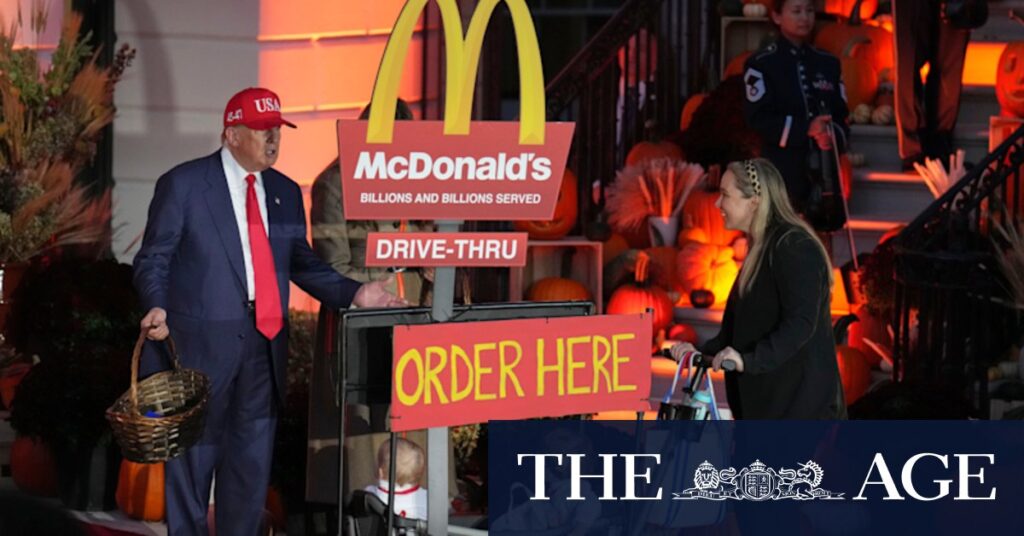
New York: In a whirlwind 24 hours, former President Donald Trump made headlines by securing a trade truce with Chinese President Xi Jinping in Busan, only to return to the White House to celebrate Halloween with children, handing out Hershey chocolate bars. Among the trick-or-treaters was a pair of babies whose pram was cleverly disguised as a drive-through McDonald’s, a costume that surely resonated with the cheeseburger-loving former president.
Trump’s six-day Asia trip was hailed by his team as a significant success. The State Department lauded him as “the greatest dealmaker in the world,” while Treasury Secretary Scott Bessent claimed that Trump was “commanding respect around the world like no other leader.” However, the highlight of the trip was undeniably his meeting with Xi, marking their first face-to-face since 2019. The much-anticipated discussion resulted in a temporary cessation of the trade war between the two economic giants, providing a year-long reprieve from the cycle of tariffs and retaliations.
Trade Truce: A Temporary Relief
The agreement is particularly welcome news for American soybean farmers, who have been heavily reliant on Chinese buyers. China has committed to purchasing 12 million tonnes of American soybeans through January, increasing to 25 million annually thereafter. Caleb Ragland, president of the American Soybean Association, praised the deal as “a meaningful step forward to re-establishing a stable, long-term trading relationship.”
Trump rated the meeting a “12 out of 10” and agreed to reduce U.S. tariffs by 10 percent, from a proposed 57 percent to 47 percent. Despite the positive headlines, experts caution that the truce may come at a significant cost.
Behind the Headlines: The Costs of Détente
Julian Gewirtz, a scholar at Columbia University and former senior director on China and Taiwan affairs for Joe Biden’s National Security Council, warns that the meeting may have emboldened Xi. “The meeting between President Trump and President Xi has been widely interpreted as a return to the status quo, but unfortunately for the U.S., it’s worse than that,” he explained. “Although some recent escalation has been paused, China has still put its significant new weapons on the table.”
“The reality is that the possibility of this temporary truce not holding for a year is all too high,” Gewirtz added.
Trump’s strategy has often relied on the assumption that the sheer size of the U.S. market would compel other countries to acquiesce to American demands. While this approach has seen success in various global deals, China presents a unique challenge. As the dominant force in critical mineral processing, Beijing holds considerable leverage.
China’s Strategic Advantage
One of Trump’s achievements in Busan was securing a one-year delay on China’s restrictions on rare earth exports, a move seen by many analysts as a bargaining chip. Wendy Cutler, senior vice president at the Asia Society Policy Institute, believes that China will continue to use this threat as “a hammer over the U.S.’s head,” undermining Trump’s tariff threats.
“The announced outcomes do little to resolve underlying structural issues that are at the heart of our bilateral economic tensions,” Cutler noted. “As such, this truce may be short-lived.”
Unlike previous agreements that favored the U.S., this time China drove a hard bargain, demanding compensation for concessions, particularly regarding tariff reductions and shipping fees. “Trump has met his match with China,” Cutler asserted, highlighting the complexity of the ongoing negotiations.
Looking Ahead: Future Negotiations
Trump plans to visit China for another meeting with Xi in April, with a reciprocal visit to the U.S. expected later. He remains optimistic about finalizing a comprehensive trade deal. For Australia, the Trump-Xi encounter, alongside Prime Minister Albanese’s recent diplomatic success, suggests that Canberra can continue to cultivate its relationship with Beijing without fear of U.S. disapproval.
Despite the initial bipartisan support for a tough stance on China during Trump’s first term, the current approach appears less coordinated, with policy decisions concentrated within a small group led by Trump himself. This shift has raised questions about the consistency and effectiveness of the U.S. strategy towards China.
As the global economic landscape continues to evolve, the implications of the U.S.-China trade relationship will be closely monitored. The temporary truce, while providing immediate relief, underscores the ongoing complexities and challenges in navigating this critical bilateral relationship.






